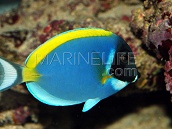Malé (Maldives)

Océan Pacifique

Colombo (Sri Lanka)

Malindi (Kenya)

Malé (Maldives)

Océan Pacifique

Malindi (Kenya)

Malé (Maldives)

Malindi (Kenya)

Acanthurus leucosternon
Toute association avec des espèces proches conduisent à des attaques généralement fatales pour l'autre poisson. Il est possible d'appliquer la sentence : à la fin, il n'en restera qu'un... Toute tentative d'associer plusieurs spécimens de A. leucosternon se solde fatalement par un échec, même en grand volume de plus de 1000 litres!
- Maintenance :
- Medium
- Compatibilité aquarium récifal :
- Green
- Taille adulte moyenne :
- 22 / 8.6
- Taille minimale de l’aquarium :
- 500 to 1000 liters
- Relations intraspécifiques :
- Solitary
Lives in a shoal of many individuals - Relations interspécifiques, ne pas maintenir en présence de :
- be wary of possible games with other acanthurus
- Dimorphisme sexuel :
- No
- Zone de vie dans l’aquarium :
- Full water
- Mise en garde :
- Slicing scalpels present at the base of the back fin
- Conseils de nos experts :
- Like most surgeons, the acclimatization of Acanthurus Leucosternon is delicate at first glance, because this family- and this species is extremely sensitive to attacks of parasites type cryptocaryon ("white dots") and it is therefore advisable Avoid fish stress so as not to weaken it. Equally usually for this family, once acclimatized to its new environment, Acanthurus Leucosternon will rather serenely live its captivity, unless it is confronted with domineering fish. The more it will be stressed, the more it can multiply the episodes of white dots, with a fatal outcome if the fish becomes too weakened.
He can accommodate the presence of other surgeons if they are of good company, everyone will tolerate according to a "politeness" protocol which will be specific to the bac. It is a fish that can sometimes be very aggressive with other fish judged as competitors, it often has a very strong character, and can cause large tensions (see ugly injuries) within the aquarium.
The ideal will undoubtedly be to spare him such competition, to ensure a serene existence. If it is sometimes found in the broad congregation on the natural reef, we will only take one specimen for the aquarium, and not a couple or more fish, which will eventually fight at one time or another.
The ideal volume of the aquarium will be at least 700 liters: it is not a very large fish, but it likes its ease and it is an excellent swimmer who appreciates speed tips.
We do not recommend his maintenance in aquarium of fish alone (Fish only), because he could see his life expectancy considerably shortened, because of stress. You might as well guarantee it the most beautiful of lives within a mature and well -balanced reef system.
This fish has the very sensitive integument, it is necessary to be careful with mycoses and the erosion of the fins and the side line. Watch out for the quality of the aquarium water, be sure to process bacterial attacks from their first signs and if you use active coal, use only a premium range specific to the marine aquariophilia (dust from The erosion of poor quality coals are recognized for their deleterious action, especially in the damage to the side line).
Remember that this fish is, like all the other fish-surgical fish, a herbivore, even if in captivity it accepts all kinds of meat food with appetite. The surgeons are big eaters because, very dynamic, they spend a lot, and they also have a relatively thick "template" to maintain. This big appetite makes them little eyebrow on the nature of the food source available, although their digestive system in the long run.
To keep this fish healthy and guarantee its longevity, it is necessary to offer it plant foods every day, in the form of fresh or lyophilized algae, or granules for herbivorous fish.
The amount of food available also conditions his "good humor": if he has to fight to eat his hunger, relationships with other aquarium fish will be felt.
His life expectancy can go up to the twenty years, if he is properly nourished and hosted in an adequate space with appropriate roommates. - Paramètre physico chimique de l’eau :
- Temperature 24-27 ° C, salinity 1.022-1.024, pH 8.0-8.4, KH 6-10, mg 1200-1400, CA 400-480, No3> 10, PO4> 0.05
- Régime alimentaire :
- Herbivore
- Origine géographique :
- Indian Ocean
Pacific Ocean
